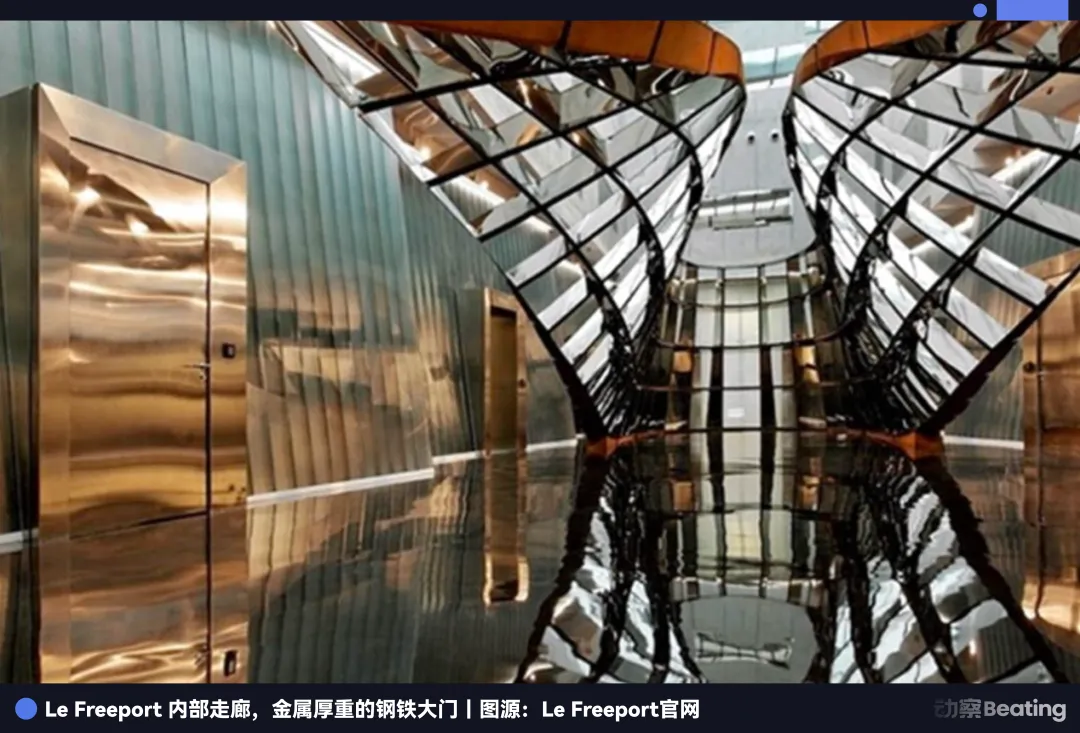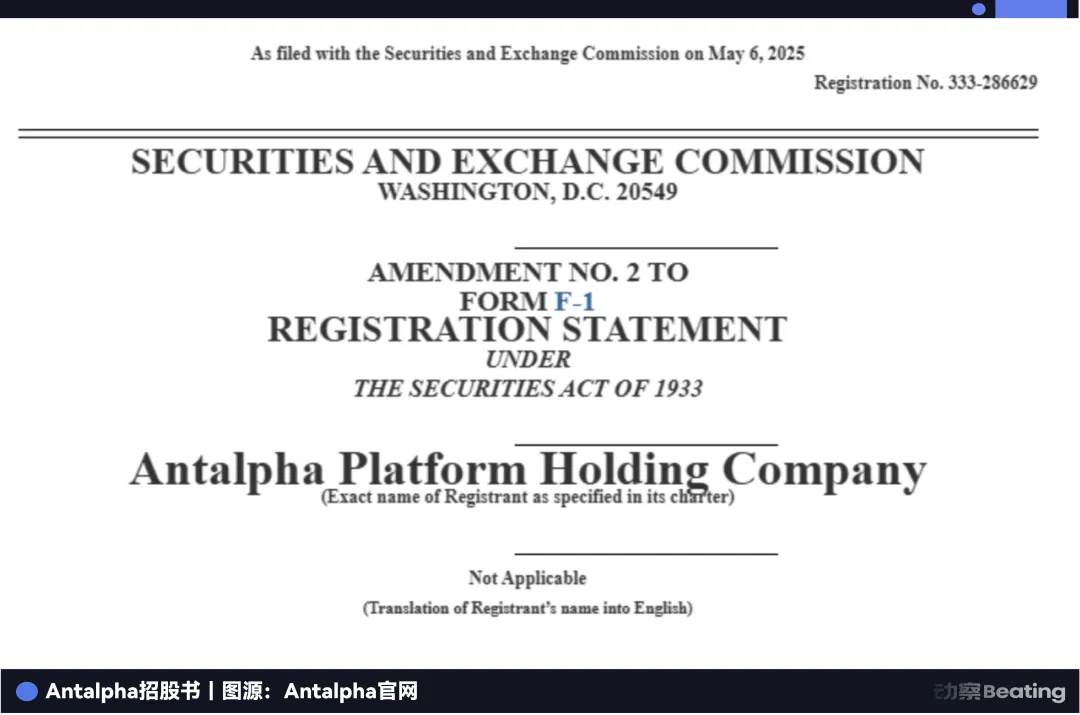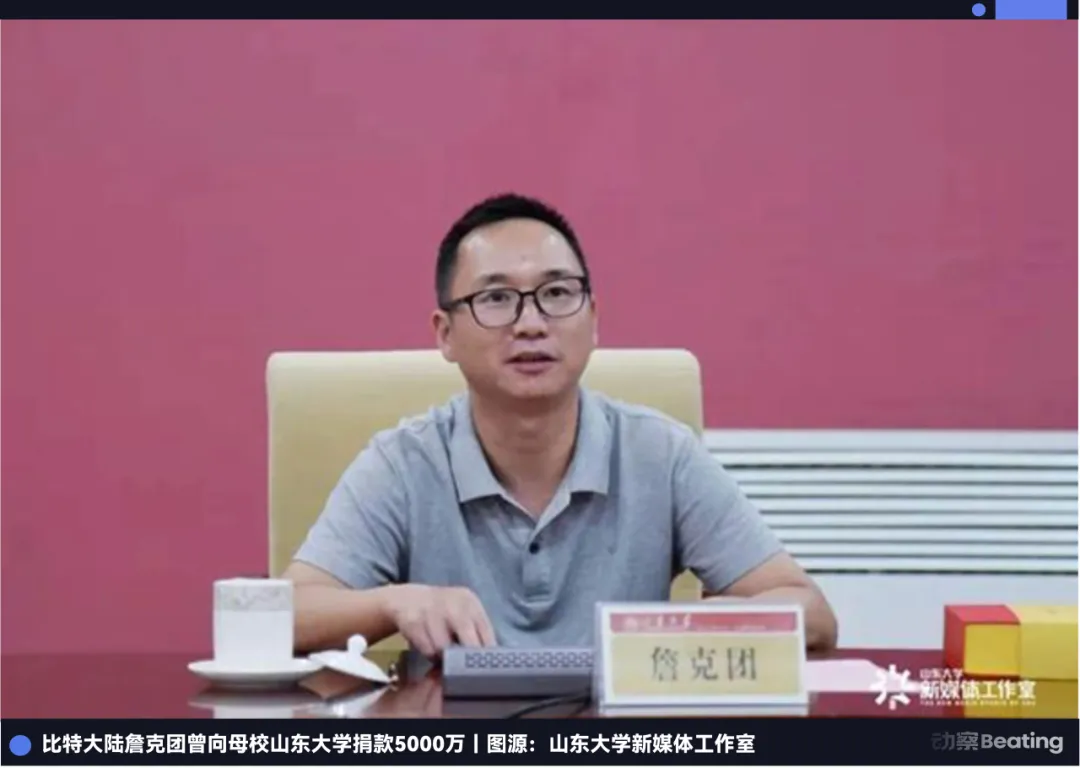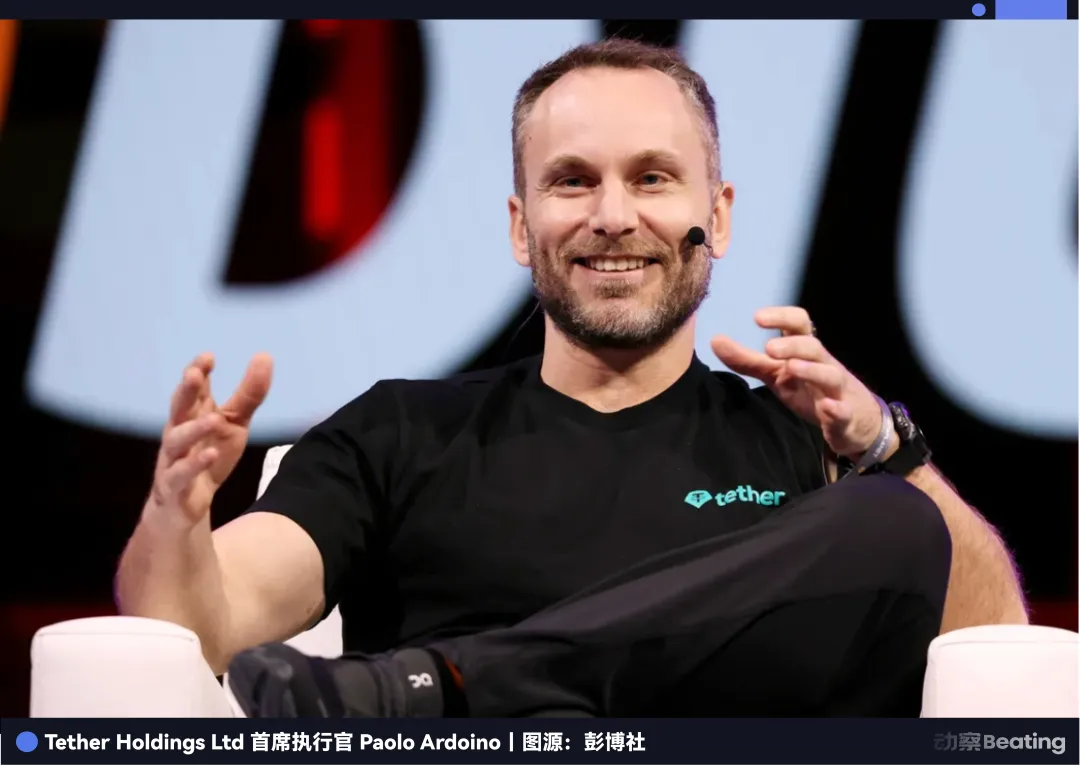When China’s Crypto Tycoons Start Buying Gold
Twelve minutes north of Singapore’s Changi Airport stands one of the world’s most secure private vaults—Le Freeport—right at the runway’s end.
With a construction cost of about 100 million Singapore dollars, this facility is often dubbed “Asia’s Fort Knox.” It has no windows, yet maintains a constant temperature of 21°C and 55% humidity year-round—the ideal environment for storing valuable art.
Behind its heavily fortified steel doors lies hundreds of millions of dollars’ worth of gold, silver, and rare art. There’s no need for customs declarations or paying taxes on these assets.
Three years ago, Jihan Wu, one of Asia’s youngest crypto billionaires and founder of Bitdeer, acquired this vault for 40 million Singapore dollars (about 210 million RMB), even though the vault was rumored to have cost as much as 100 million Singapore dollars to build.

Bloomberg confirmed the deal, revealing Bitdeer, led by Wu, as the buyer. At the time, some in the crypto community mocked this as a “side venture”—why buy an off-chain vault instead of focusing on Bitcoin mining?
Yet, when gold prices soared past $4,000 per ounce in 2025, this acquisition proved to be a prescient move rather than a distraction.
Wu’s purchase of Le Freeport was never just about concrete and steel. From the outset, this fortress was purpose-built as a bonded enclave for ultra-high-net-worth individuals and institutions: top-tier security, discreet exhibition space, and seamless ways to bypass multiple layers of tariffs.
The move highlights an important truth: China’s Bitcoin millionaires have long set their sights on the oldest safe-haven asset in history—gold.
Gold’s Retirement Home
Le Freeport officially opened in Singapore in May 2010. Designed as essential infrastructure, it sits right next to the airport, with internal corridors nearly reaching the runway. It takes only minutes to move valuables from the plane to the vault.
Singapore’s supportive approach is embedded in its shareholding structure: both the National Heritage Board and National Arts Council were among Le Freeport’s founding shareholders.
Singapore was transforming from a “trading port” to an “asset port.” Le Freeport became part of the Global Arts and Wealth Management Center Initiative and benefited from the Zero GST Warehouse Scheme, making it one of the few vaults worldwide to offer tax exemption, bonded status, and cross-border settlement capabilities.
These policies quickly brought Le Freeport to the attention of global elites and institutions. It accommodates large physical assets, is open to non-Singaporean owners, and requires neither immigration procedures nor customs duties.
For example, storing a $50 million Picasso at Le Freeport, with tax rates of 10%–30%, could mean saving tens of millions in taxes.
Since Le Freeport has never released interior photos, our only glimpse comes from images published by its neighbor, The Reserve, a newly established vault.

Le Freeport once attracted a roster of premier institutional tenants: JPMorgan (one of the world’s largest gold dealers), Christie’s subsidiary CFASS, UBS, Deutsche Bank, and other international financial powerhouses. Large amounts of gold bars passed through it for cross-border transit and storage.
But as some countries tightened their regulation of luxury goods and offshore assets, these institutions gradually vacated, leaving Le Freeport in long-term financial loss.
By 2017, Le Freeport was classified as a “distressed asset” and was put up for sale. It would be five years before Jihan Wu emerged as a buyer.
At the time, the crypto market was in the midst of a true winter: the collapse of the LUNA algorithmic stablecoin shook confidence in on-chain credit, Three Arrows Capital declared bankruptcy, Celsius and BlockFi imploded, and a chain reaction of deleveraging ultimately culminated in FTX’s collapse—fully exposing counterparty risk.
During this period, Chinese crypto entrepreneur Jihan Wu, through Bitdeer, acquired this so-called “hot potato” for about 40 million Singapore dollars (roughly 210 million RMB).
Wu co-founded Bitmain, the world’s largest manufacturer of mining rigs, once controlling approximately 75% of global Bitcoin hash rate and serving as a central figure in the previous mining cycle. After spinning off Bitdeer, he relinquished control of Bitmain, became a Singapore permanent resident, and focused on Bitdeer’s computing power and infrastructure business.
Wu has rarely commented on the acquisition, only confirming it when questioned by Bloomberg.
Today, Le Freeport’s website makes it clear: this is more than a vault—it’s an exclusive, private experience for a select few.
While crypto investors spend a lifetime learning to safeguard private keys, true wealth has long been stored in Singapore’s vaults—sometimes as family trust documents, sometimes as mnemonic phrases etched into steel plates.
Not only Chinese billionaires, but newly affluent individuals from India and Southeast Asia are quietly joining Wu’s Le Freeport clientele.
Le Freeport has never disclosed its client list, but international auction data offers hints: many artworks are placed “directly into storage” after sale, never returning to market circulation.
A similar pattern is emerging across Southeast Asia, where listed billionaires transfer portions of their liquidity directly into Le Freeport: gold and silver bars, haute joaillerie, limited-edition Patek Philippes, vintage cars, and rare artworks make their way straight from the trading floor to this secretive warehouse.
For prospective vault members among our readers, here’s how the gold storage process works.
Armed guards monitor the entrance. Visitors must undergo online background checks using their passports to confirm they aren’t high-risk individuals. To access the core vault area, at least five layers of security must be cleared, including identity verification, biometrics, bulletproof doors, and personal item screening. More than a hundred high-definition cameras provide 24/7, no-blind-spot monitoring. Add to this the physical challenge—“30 kg silver bars, 12.5 kg gold bars”—and even if intruders gained entry, they could barely move anything.

While outsiders debate whether “gold can still go up,” the real insiders are already planning how many cases of $150,000 Romanée-Conti to store or which shelves and racks to use for Picassos and Rembrandts—so their wives can photograph and catalog them.
The average worker ends up with a retirement account, but Asia’s ultra-wealthy finish behind these windowless walls in Singapore.
Of course, a vault’s physical space is only part of the game. To secure greater influence over the gold supply chain, one must move further upstream.
Fujian’s Golden Bloodline
While everyday buyers queue for small discounts at gold shops, old-money families and blockchain elites are competing by the ton—who truly controls the market?
This May, fintech company Antalpha filed its IPO prospectus with Nasdaq. The filing referenced Bitmain, the mining company co-founded by Jihan Wu.
The prospectus states: “We are Bitmain’s primary financing partner.” The two parties signed a memorandum of understanding to continue cooperation and refer clients to each other.

Antalpha previously provided supply chain loans and client financing for Bitmain, the world’s largest mining rig manufacturer—a legacy of the Jihan Wu era.
Now, with Wu long departed, Bitmain is led by another co-founder—crypto billionaire Micree Zhan, who hails from Fujian.
Many parts of China revere gold, but Fujianese have a special connection: Chen Jinghe from Longyan turned a “worthless” mine into Zijin Mining, a ten-bagger and global mining giant; Zhou Zongwen from Fuqing founded Chow Tai Seng in Shuibei, using franchising to enter China’s top three jewelry brands; goldsmiths from Putian went from traveling artisans to dominating nearly half of China’s gold retail and wholesale.
With gold mines, gold shops, and gold magnates all hailing from Fujian, one might say the Fujianese have gold in their veins.
Clearly, Micree Zhan’s bloodline has been ignited—how could the Fujianese miss out on blockchain gold?

He’s now set his sights on Tether, the world’s largest stablecoin issuer and also a top-30 gold buyer globally—a newly minted “on-chain gold giant.”
In October, Tether announced a partnership with Antalpha to launch a “Tokenized Gold Treasury,” targeting a $200 million raise. The system uses XAU₮ tokens backed by gold, creating a gold-collateralized digital lending ecosystem.
The division of labor is distinctively Fujianese: Tether mints tokens backed by real gold and stores reserves in Swiss private vaults. Antalpha turns these tokens into financial instruments—designing collateral structures and loan products, and building out gold-vault networks in Singapore, Dubai, and London—so “on-chain gold” can be instantly redeemed for physical gold bars.
In short, it’s a modern twist on the gold standard: Tether as the mint, Antalpha as the banker, but with the narrative now set in Swiss vaults rather than Bretton Woods.
Public reports indicate Tether holds about 80 metric tons of gold in Swiss vaults—comparable to the official reserves of some smaller nations. However, citing “security concerns,” Tether refuses to disclose the vault addresses.

Unlike central banks that “lock up gold bars in cellars for decades,” XAU₮ is tokenized, on-chain, trackable, divisible, tradable, and can be pledged. Gold that once languished in vaults is now “dynamic liquidity”—freely circulating, pledged, and even wholesaled to institutions.
Antalpha’s own subsidiary, Aurelion, invested $134 million to buy XAU₮ directly, aiming to become the “first listed treasury company with on-chain gold as a reserve asset.” This replaces the old-money model of “filling Swiss vaults with gold bars” with “listing XAU₮ holdings on the public company’s balance sheet.”
Tether CEO Paolo Ardoino captured the core logic: “Gold and Bitcoin are the two ends of the same logic—one is the oldest store of value, the other is the most modern.”
Gold prices are proving this new thesis: global gold investment is up over 50% this year, and XAU₮’s market cap has doubled. For once, risk-averse and risk-seeking investors are on the same side.
They’re asking a bigger question: Can the world’s oldest form of wealth storage be reborn on the blockchain?
A Break from Tradition
In October 2025, gold prices surged past $4,000 per ounce, setting a new all-time high with annual gains of over 50%—making it one of the world’s top-performing assets.
On the surface, this looked like another “gold bull run.” But beneath it, three forces were reshaping the gold market’s power structure.
First up: central banks. Over recent years, they’ve “bought the dip,” using gold as the foundation for de-dollarization and sanctions hedging. They care little about short-term swings; their only concern is whether, in a crisis, gold can still be traded for food, weapons, or alliances.
Next come Asia’s ultra-wealthy. Capital from China, Hong Kong, the Middle East, and Southeast Asia is quietly piling up new “gold walls” via Singapore vaults, Swiss cellars, and family office trusts.
They’re no longer satisfied with a few kilograms of “paper gold” at a bank; they buy entire vault walls. Some deposit cash in Singapore banks, others store gold bars directly in vaults—each approach offering a fundamentally different sense of security.
Jihan Wu’s purchase of Le Freeport is a key link in this chain: from mining Bitcoin to safeguarding others’ gold and masterpieces, shifting from “on-chain yield” to “off-chain security.”
The third force: crypto’s new elite. Micree Zhan, Antalpha, and Tether play a different game—Wu buys vault walls; they buy the digital row in the vault’s ledger—XAU₮.
In this system, Tether mints tokens backed by real gold and locks them in Swiss vaults; Antalpha turns these tokens into assets, adding them to corporate balance sheets and client collateral baskets.
Gold’s role is being quietly rewritten: for central banks, it remains the “ultimate collateral”; for Asia’s wealthy, it’s a “family cold wallet” for passing wealth across generations; for crypto’s new elite, it’s a financial system built to layer structures and capture liquidity premiums and spreads.
For most, gold is just a chart and a weight. For these three groups, it’s a master ledger of family, sovereignty, and national security.
The narrative constantly shifts, but the underlying assets remain ancient. However the story is spun, capital is ruthlessly honest: when the curtain falls and the lights come on, all they want is a sense of security that lets them sleep at night.
Statement:
- This article is reprinted from [动察Beating], with copyright belonging to the original author [Lin Wanwan]. If you have any concerns regarding this reprint, please contact the Gate Learn team, who will handle it according to relevant procedures.
- Disclaimer: The views and opinions expressed in this article are solely those of the author and do not constitute investment advice.
- Other language versions of this article are translated by the Gate Learn team. Without proper reference to Gate, do not copy, distribute, or plagiarize translated material.
Related Articles

The Future of Cross-Chain Bridges: Full-Chain Interoperability Becomes Inevitable, Liquidity Bridges Will Decline

Solana Need L2s And Appchains?

Sui: How are users leveraging its speed, security, & scalability?

Navigating the Zero Knowledge Landscape

What is Tronscan and How Can You Use it in 2025?
